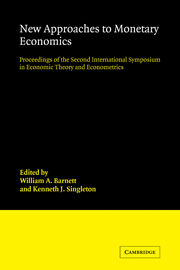 New Approaches to Monetary Economics
New Approaches to Monetary Economics Book contents
- Frontmatter
- Contents
- Editors' introduction
- List of contributors
- Part I Transactions motivated monetary holdings in general equilibrium
- Part II Financial intermediation
- Part III Monetary aggregation theory
- Part IV Issues on aggregate fluctuations
- Part V Theoretical issues in the foundations of monetary economics and macroeconomics
- 15 Pricing and the distribution of money holdings in a search economy, II
- 16 The optimal inflation rate in an overlapping-generations economy with land
- 17 Some unsolved problems for monetary theory
16 - The optimal inflation rate in an overlapping-generations economy with land
Published online by Cambridge University Press: 04 August 2010
- Frontmatter
- Contents
- Editors' introduction
- List of contributors
- Part I Transactions motivated monetary holdings in general equilibrium
- Part II Financial intermediation
- Part III Monetary aggregation theory
- Part IV Issues on aggregate fluctuations
- Part V Theoretical issues in the foundations of monetary economics and macroeconomics
- 15 Pricing and the distribution of money holdings in a search economy, II
- 16 The optimal inflation rate in an overlapping-generations economy with land
- 17 Some unsolved problems for monetary theory
Summary
Abstract: This paper is concerned with the optimal inflation rate in an overlappinggenerations economy in which (i) aggregate output is constrained by a standard neoclassical production function with diminishing marginal products for both capital and labor, and (ii) the transaction-facilitating services of money are represented by means of a money-in-the-utility-function specification. With monetary injections provided by lump-sum transfers, the famous Chicago Rule prescription for monetary growth is necessary for Pareto optimality; but a competitive equilibrium may fail to be Pareto optimal with that rule in force because of capital overaccumulation. The latter possibility does not exist, however, if the economy includes an asset that is productive and nonreproducible – that is, if the economy is one with land. As this conclusion is independent of the monetary aspects of the model, it is argued that the possibility of capital overaccumulation should not be regarded as a matter of theoretical concern, even in the absence of government debt, intergenerational altruism, and social security systems or other “social contrivances.”
Introduction
Most of the existing analyses of the optimal inflation rate that have been carried out in models with finite-lived individuals have reached conclusions that seem to contradict the famous Chicago Rule for optimal monetary growth. An exception is provided by McCallum (1983, p. 38), which suggests that analysis of overlapping-generations models is supportive of the Chicago Rule provided these models take account of the transactionfacilitating (i.e., medium-of-exchange) services of money.
- Type
- Chapter
- Information
- New Approaches to Monetary EconomicsProceedings of the Second International Symposium in Economic Theory and Econometrics, pp. 325 - 339Publisher: Cambridge University PressPrint publication year: 1987
- 12
- Cited by


